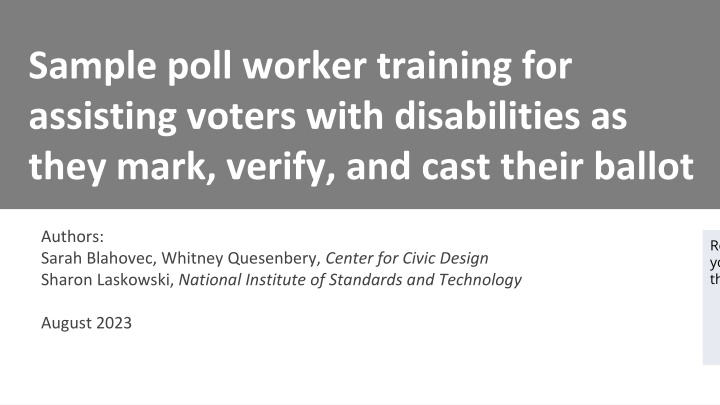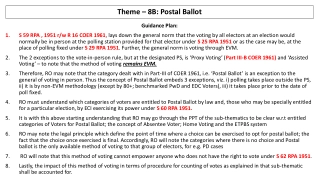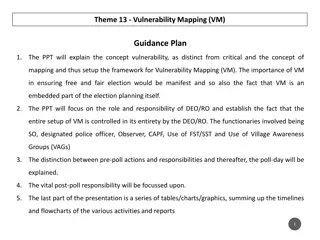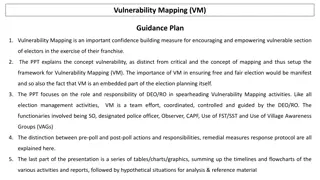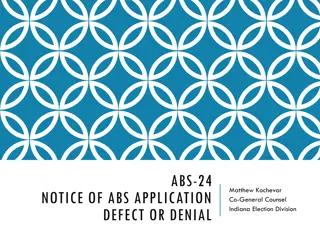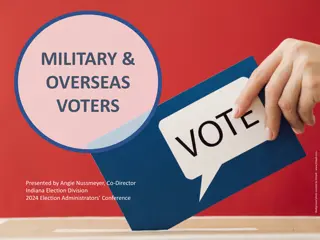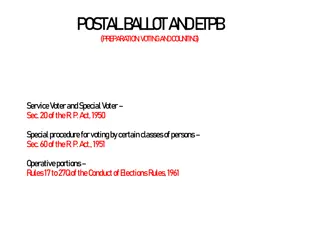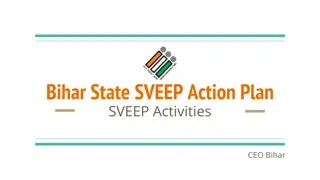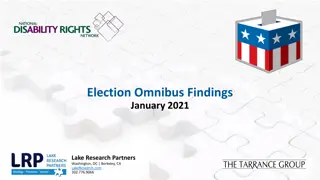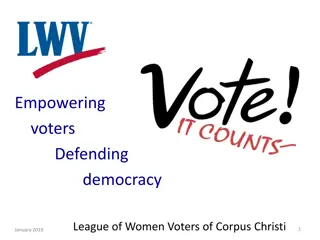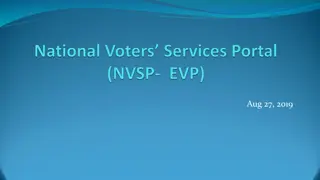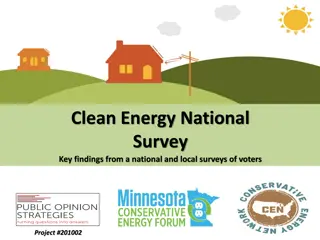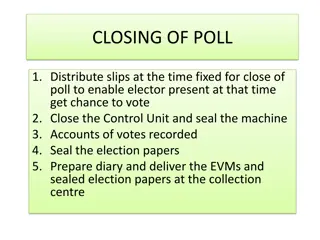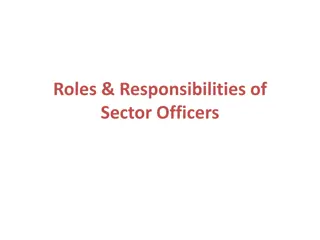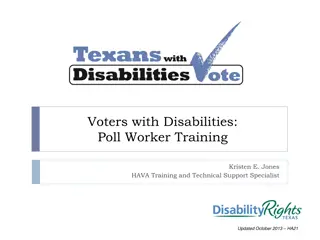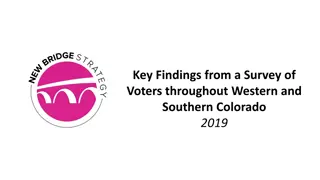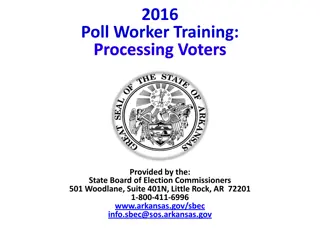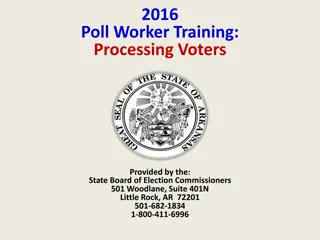Poll Worker Training for Assisting Voters with Disabilities
This training module focuses on assisting voters with disabilities as they mark, verify, and cast their ballot. It covers disability rights, accessible voting systems, voter assistance, and more to ensure equal access to voting for all individuals.
Download Presentation

Please find below an Image/Link to download the presentation.
The content on the website is provided AS IS for your information and personal use only. It may not be sold, licensed, or shared on other websites without obtaining consent from the author.If you encounter any issues during the download, it is possible that the publisher has removed the file from their server.
You are allowed to download the files provided on this website for personal or commercial use, subject to the condition that they are used lawfully. All files are the property of their respective owners.
The content on the website is provided AS IS for your information and personal use only. It may not be sold, licensed, or shared on other websites without obtaining consent from the author.
E N D
Presentation Transcript
Sample poll worker training for assisting voters with disabilities as they mark, verify, and cast their ballot Authors: Sarah Blahovec, Whitney Quesenbery, Center for Civic Design Sharon Laskowski, National Institute of Standards and Technology Remove this slide after you have customized this presentation August 2023 Poll worker training for assisting voters with disabilities | 1
How to customize this training for your jurisdiction This training is intended to be part of your training for poll workers, focusing on how to assist voters with disabilities, while supporting private and independent voting. In the slides: Text and image placeholders highlighted in grey should be customized to your own voting systems and procedures (and then removing the highlight) There are also customization notes on some slides in a grey box on the right that should be removed Slide notes contain additional information you might want to use in your training. Some slides can be removed if they do not apply to your jurisdiction. Remove this slide after you have customized this presentation Poll worker training for assisting voters with disabilities | 2
Assisting voters with disabilities as they mark, verify, and cast their ballot Put your jurisdiction name, logo, or other credits here Poll worker training for assisting voters with disabilities | 3
About this training This module of poll worker training covers: Disability rights during voting Accessible voting systems Assisting voters with disabilities How to assist voters Checking in a voter Setting up the voting system While they are voting While they are verifying and casting their ballot Summary and resources Poll worker training for assisting voters with disabilities | 4
Disability rights during voting There needs to be equal access to the ballot box so people with disabilities can exercise their constitutional right to vote. Voter comment from (page 7 of the RFI) Public comment from NIST Request for Information for E.O. 14019, Promoting Access to Voting Poll worker training for assisting voters with disabilities | 5
What is a disability? The Americans with Disabilities Act of 1990 says: The term disability means, with respect to an individual: (A) a physical or mental impairment that substantially limits one or more major life activities of such individual; (B) a record of such an impairment; or (C) being regarded as having such an impairment. Poll worker training for assisting voters with disabilities | 6
What rights do voters with disabilities have? Accessible voting systems are required by the Help America Vote Act (HAVA). Every voter with and without a disability has the right to use an accessible voting system Some voters with disabilities need the accessible voting system to vote privately and independently, especially: o Voters who are blind or have low vision o Voters with mobility disabilities or lack manual dexterity o Voters with cognitive disabilities Voters may use a screen magnifier on their phone, even if phones are not permitted in the polling place Poll worker training for assisting voters with disabilities | 7
What are the accessibility requirements for voting systems? The federal standards, called Voluntary Voting System Guidelines (VVSG) 2.0, say that systems must provide: Equivalent and consistent voter access, with equivalent information and options in all modes of voting. Voter privacy so people can vote privately and independently (without assistance from others). Voters can mark, verify and cast their ballot as they intend because ballots are presented in way they can perceive (see or hear), operate the system, and understand the ballot information and instructions. Poll worker training for assisting voters with disabilities | 8
Accessible voting systems A voting system is accessible for individuals with disabilities, including nonvisual accessibility for the blind and visually impaired , if it provides the same opportunity for access and participation (including privacy and independence) as for other voters. Help America Vote Act of 2002 Section 301 Poll worker training for assisting voters with disabilities | 9
How do accessible voting systems support voters? What it does How it helps Audio ballot Helps voters who are blind, have low vision, or who do not read well, by reading the ballot aloud Put a photo of your systems controller here. Tactile controller and other assistive devices Allows voters using the audio ballot or people with mobility disabilities to navigate and make their choices with buttons they can identify by touch Setting text size Helps voters with low vision and cognitive disabilities by making the text easier to see A tactile controller has physical buttons that can be identified by touch. Changing contrast Allows voters with low vision to make the text stand out from the background Personal assistive technology In some systems, voters can bring their own input controls (assistive technology) or hearing devices Poll worker training for assisting voters with disabilities | 10
Our accessible voting system: [insert name of your system here] The features of this system include: [Audio ballot] [Tactile controls] [Change text size and contrast] [Sip-and-puff controls] [Ability to plug in their own assistive technology] [Set up at a height for sitting] [add any more, remove any you don t have] Put a photo of your system here. If you have an illustration with callouts to identify accessible features, you can use it here. You can learn more about these features at [poll worker manual reference] Poll worker training for assisting voters with disabilities | 11
Assisting voters with disabilities [The poll workers] explained the operation and voting procedure very clearly. After filling out my ballot by myself and completing the whole process, I had a wonderful feeling of self-satisfaction being able to do my civic duty to vote. Public comment from NIST Request for Information for E.O. 14019, Promoting Access to Voting Poll worker training for assisting voters with disabilities | 12
Customize this slide to match what your poll workers have available. What tools do you have to help you assist voters? Use this slide to introduce Procedures and forms Job aids for the accessible voting system features ASL interpreters if available remotely or in the polling place Who to contact if you need help troubleshooting a problem In all the slides text that needs customization is highlighted in grey Poll worker training for assisting voters with disabilities | 13
Update the language on this slide to reflect your state s rules around poll workers providing assistance (such as if the state requires two poll workers from opposing parties to assist a voter) Who may assist voters? If voters need help setting up the voting system or marking their ballot, they are entitled to assistance. Who may assist voters: Who may not assist voters: If your state has specific restrictions or rules around who can and cannot assist a voter, insert those rules on this slide. A person of the voter s choice, such as a family member or personal care attendant [A poll worker] or [Two poll workers from different parties] [Insert any other state rules or procedures] A voter s employer or an agent of their employer An officer or agent of the voter s union [Insert any other state rules or procedures] Poll worker training for assisting voters with disabilities | 14
Remove this slide if this is not required in your jurisdiction. Fill in the form for assistants as part of the election record The names of people who assist a voter are recorded on the [Title of the Form]. Collect their Full name Relationship to the voter Address Signature Show a copy of the form, so that poll workers will recognize it. Poll worker training for assisting voters with disabilities | 15
How can assistance be given fairly and impartially? When giving assistance, let the voter tell you what kind of help they need. Let the voter do as much as possible by themselves. Make your best effort to preserve a voter s privacy as they mark their ballot. Be neutral and nonpartisan. Do not give out advice or make comments on a voter s choice or try to influence a voter s choice. Be consistent in the instructions you give, so that all voters get equivalent information. Poll worker training for assisting voters with disabilities | 16
How can assistance support voter privacy while voting? Emphasize privacy and avoid looking at their ballot once they start voting Position yourself so they can see you Don t look over their shoulder at the screen After giving assistance, move away to give them privacy If you are assisting a voter with a vision disability, verbally communicate that you are moving away Let the voter know how they can get your attention if they need more help Poll worker training for assisting voters with disabilities | 17
Communicating with Deaf, DeafBlind, and hard of hearing voters Tip for communicating If they have an interpreter or support person, talk to the voter, not the interpreter Use gestures Rephrase your answers Don t raise your voice unless asked Be patient Ways of communicating There are many different ways to communicate. Some examples: Sign language interpreters Not all Deaf, DeafBlind, or hard of hearing voters use American Sign Language (ASL) Writing back and forth on a piece of paper [ If the polling place has ASL interpretation available, add it here ] Captioning apps Poll worker training for assisting voters with disabilities | 18
How to assist voters: Checking in a voter I have a long wait every time I go to vote [because] the poll workers don't know how to turn the voice on in the voting machine. Sometimes it takes two hours for them to figure out how to turn [it] one . I have also been asked if someone could help me vote. I deserve to vote independently and privately, as is my right." Public comment from NIST Request for Information for E.O. 14019, Promoting Access to Voting Poll worker training for assisting voters with disabilities | 19
Ask voters how they want to vote All voters have the option to vote on an accessible voting system. Ask them: Would you like to vote on a paper ballot, or would you like to use the accessible voting system today? Remember Do not comment on a voter s choice to use the accessible machine Not all disabilities are apparent or visible If a voter wants to vote on the accessible voting system, you may not ask if they have a disability or why they need the machine. Poll worker training for assisting voters with disabilities | 20
[When a voter chooses to use the [accessible system] This slide is only for jurisdictions that have restrictions on who may use the accessible voting system or have a form that a voter must fill out. [If there are any special restrictions, rules or procedures, list them here and show any forms or affidavits that must be filled out. This form is different from the one for people who assist a voter. If anyone can use the accessible system without any special procedures, delete this slide] Show a copy of the form, so that poll workers will recognize it. Poll worker training for assisting voters with disabilities | 21
Remove this slide if this is not used in your jurisdiction. Curbside Voting with an accessible voting system [If your polling place offers curbside voting with an accessible voting system, describe specific procedures or instructions] Poll worker training for assisting voters with disabilities | 22
How to assist voters: Setting up the voting system I have a long wait every time I go to vote. The primary issue is the poll workers don't know how to turn the voice on in the voting machine. Sometimes it takes two hours for them to figure out how to turn on the voice, and I sit there, holding up the line in my tiny precinct. Public comment from NIST Request for Information for E.O. 14019, Promoting Access to Voting Poll worker training for assisting voters with disabilities | 23
Adjusting the system: physical setup Before the voter even starts the system, they may need it physically adjusted. On our voting system we can [ Raise or lower the height of the screen or controls ] [ Tilt the screen for a better view or to avoid glare ] [ Add any other adjustments possible for your accessible voting system ] Put a picture here for how to adjust the physical setup of the system Poll worker training for assisting voters with disabilities | 24
Adjusting the system: system controls The next step is to make sure the voter has the system set up so they can interact with it. Our systems include: [ The # button tactile keypad] [ Paddles or dual switches ] [ Sip-and-puff ] [ Audio output with the screen on or off ] [ if there is a screen to set up the system controls, show it here] Poll worker training for assisting voters with disabilities | 25
Help voters learn the buttons on the controller If the voter is using the tactile controller, ask if they would like an orientation to the main features. [ You can also direct them to the tutorial in the system. ] Focus on the buttons to navigate and mark the ballot. On our system: [ buttons to scroll within a contest ] [ button to select a candidate or option ] [ buttons to move from page to page ] Describe buttons by shape and location, not just color Show the controller and button layout here. Poll worker training for assisting voters with disabilities | 26
Adjusting the system: screen display Finally, there are screen display and audio options. Help the voter make these adjustments before starting to vote, so that you can assist them without seeing their ballot. Our systems include: [ # text sizes] [ # options for color contrast ] [ Audio volume ] [ Audio speed (or rate) ] Put a picture here of the system accessibility options for adjusting the screen and audio Poll worker training for assisting voters with disabilities | 27
Customize the script to include the features on your accessible voting system. Follow the script so you don t leave anything out. This is the accessible voting system. You will use it to read and mark your ballot. Once you re done, you ll [print the ballot and take it to the scanner] [review and cast your ballot]. You can make the text larger and smaller, change the contrast. It also has [insert other features]. If you want to use the audio ballot, the headphones and controller are in front of you. You can change the volume and speech rate. [Some screens have more than one contest on a page][Some contests have many candidates], so make sure that you scroll to the bottom of the page to see all the choices. Do you have any questions? Poll worker training for assisting voters with disabilities | 28
Adjust this slide to be consistent with the script on the previous slide and to match your jurisdiction. Edit the speaker notes to match Include important reminders about how to vote [Voters may need to scroll to see all contests/choices on a page] Voters can verify their choices before printing/casting their ballot If the voter finds a mistake after they print their ballot, they can spoil the ballot. When starting a voting session, let the voter know what features are available: The voting machine can [read the ballot to you, make the text larger or smaller, etc] Let them know that headphones and a controller are available Offer them but do not place the headphones on the voter unless they ask Remind them that they will mark their ballot on the accessible system, and [they must then print it and take it to the scanner to cast it] [the ballot is cast at the machine] Poll worker training for assisting voters with disabilities | 29
How to assist voters: While they are voting "While I was voting the poll worker stepped back about 20 feet and waited until I was finished voting. " Public comment from NIST Request for Information for E.O. 14019, Promoting Access to Voting Poll worker training for assisting voters with disabilities | 30
Be available to help, but dont hover If a voter asks for help while they are voting: Some voters may need more time to be able to vote, so don t rush them. Do not speak over an audio ballot session. Let the voter know a poll worker will be nearby but not looking at their ballot. If you are going to remain very close by but you aren t helping the voter, turn your back to the screen or make sure it is out of your sight line. Try to answer their question without looking at the screen. Poll worker training for assisting voters with disabilities | 31
Let the voter know what you are doing In addition to letting voters tell you what help they need, you can tell them what you will do to help them. For example, if they need help while they are voting, you might say: I would need to look at the screen to answer your question. Once I m done, I will move away to give you privacy so that you can continue voting. Is that okay? If so, Let me know when you are ready for me to look at the screen. Poll worker training for assisting voters with disabilities | 32
Troubleshooting during the voting session Communicate directly with the voter: Even if they have an assistant or interpreter Explain what you are doing Let them know if you are waiting for assistance or how long it may take Troubleshoot the problem as much as possible Let them know about any alternative options, but don t pressure them to vote on a paper ballot if they want to use the accessible voting system Poll worker training for assisting voters with disabilities | 33
How to assist voters: While they are verifying and casting their ballot Once the paper print ballot is released from the machine, we should have an envelope immediately provided at the machine to avoid the poll worker or anyone else to "peek" and see our voting choices. Public comment from NIST Request for Information for E.O. 14019, Promoting Access to Voting Poll worker training for assisting voters with disabilities | 34
Helping voters verify and cast their ballot Voters should verify their choices before [printing] [casting] the ballot. Voters can spoil a ballot after printing it, and have three tries. Handling the printed ballot Let the voter handle the ballot themselves unless they ask for help If the voter needs help with handling the ballot, ask before taking it from them [ Place the ballot in secrecy sleeve ] Poll worker training for assisting voters with disabilities | 35
Remove this slide if your jurisdiction does not use a scanner or where voters cast their ballot at the voting booth. Helping voters get to the scanner Ask the voter if they would like assistance getting to the scanner For voters who are blind or have low vision: Tell the voter where the scanner is located and offer to guide them If they want you to guide them, do not grab them. Offer them your elbow so they can walk with you to the scanner If they have a service animal, stand on the opposite side of the voter from the animal Poll worker training for assisting voters with disabilities | 36
Remove this slide if your jurisdiction does not use a scanner. Helping voters scan their ballot Tell voters who are blind or low-vision where and how to insert the ballot Tap the scanner where they will insert the ballot for an audio cue If using privacy sleeves, let them know they can feed the ballot through the sleeve If there is an error message, maintain ballot privacy while troubleshooting Poll worker training for assisting voters with disabilities | 37
When they are done Offer the voter their I voted sticker Don t try to put the sticker on the voter, let them ask if they need help For voters with blindness or low vision, let them know how the sticker is oriented so they don t put it on upside down Ask them if they need directions to the polling place exit Poll worker training for assisting voters with disabilities | 38
Summary and resources "Having the accessible voting machine already set up in the poll workers familiar with its set up an operation speeds up the process and makes it less unequal in experience for disabled voters." Public comment from NIST Request for Information for E.O. 14019, Promoting Access to Voting Poll worker training for assisting voters with disabilities | 39
Summary: Do Offer every voter the option to use the accessible voting system Ask if a voter needs help If the voter is listening to the audio ballot, wait until they signal you that they are ready before you speak to them Give voters time to vote. Everyone votes at a different pace Offer a voter headphones if they are voting by audio ballot [BMDs] Offer to help them navigate to the scanner or ballot box Troubleshoot a voter s problem as much as possible, so they can vote privately and independently Poll worker training for assisting voters with disabilities | 40
Summary: Dont Ask someone about what disability they have Assume a voter needs help Speak over a voter s audio session Rush a voter if you think they are taking too long Place headphones on a voter unless they ask you to Take a voter s ballot to the scanner unless they ask you to Try to discourage someone from using the accessible voting system if they re having a problem Poll worker training for assisting voters with disabilities | 41
Your Election Day Resources Use this slide to review Procedures and forms Job aids for the accessible voting system feature Any other information in the poll workers manual ASL interpreters if available remotely Who to contact if you need help troubleshooting a problem Poll worker training for assisting voters with disabilities | 42
